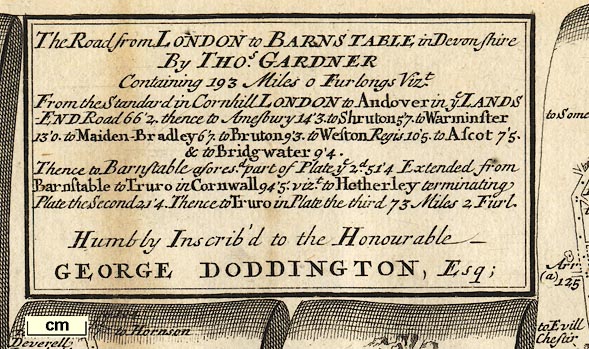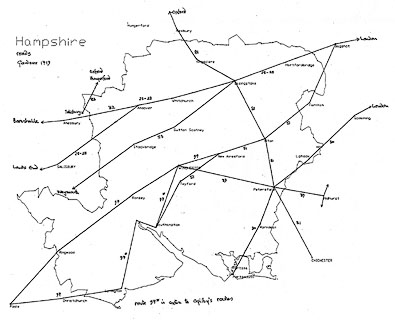
 Map Group GARDNER 1719
Map Group GARDNER 1719








plain cartouche
table of distances
dedication

Each plate has a plain rectangular cartouche, not fitting well in the curve of the scrolls. In this is given the name of the route, map maker's name, distances in stages and overall, and a dedication. Example, plate 51:-
The Road from LONDON to SOUTHAMPTON,
By THOS. GARDNER.
Containing 78 Miles 3 Furlongs Vizt. From ye Standard in Cornhill LONDON to Bagshot in ye Lands end Road 29'6 thence to Farnham 11'6, to Alton 9'3, to Aleresford 9'6, to Twiford 8'6, to Southampton 9'5. Continued to Salisbury Com. Wilts 25'5. Vizt. From Southampton to Rumsey 8'3, to White Parish 9, & to SALISBURY 8'2.
Humbly Inscrib'd to the Honourable JOHN WALLOP, Esq.Plate 32 is dedicated to:-
GEORGE DODDINGTONPlate 53 is dedicated to:-
JOHN HARRISONI have not been able to discover clear connections between the dedicatees and the maps, BUT -
George Doddington might have been George Bubb Dodington b.1691 d.1762 who was MP for Winchelsea 1715, took his name on succeeding to an uncle's estate 1720, and was later MP for Bridgewater, 1722-54.
John Wallop might have been the John of Farleigh Wallop b.1690 d.1762, MP for Hampshire 1715-20, later Lord Lieutenant of Hampshire 1733-42, and created 1st Earl of Portsmouth 1743.
compass rose
up is destination

Each scroll has a simple compass rose to declare its orientation; circles, four lines for the cardinal directions, north marked by a fleur de lys. The compass rose is sometimes more elaborate, for example on the first scroll of plate 32, where there are star points for cardinal and half cardinal directions, lines for the false points, a fleur de lys marking north.
Up on the pages is towards the traveller destination, which matches his view forward.

The maps have no declared scale. A scale could be estimated by measuring segments of road, using the mile marks provided. The maps are about:-
2 miles to 1 inch
The Sea
coast form lines

Where it is shown there are form lines emphasising the coast line.
ferries
bridges
ponds

Wey flu.
river TestSmaller rivers are drawn by a smaller wiggly line, down to a:-
Rillcrossing under the road. Some small stream are drawn a little larger and might be named, eg:-
small River call'd Sewers water
Brambr. waterThe last being a stretch of the Itchen, pl.51 scr.4 mile 71.
At Southampton
the Ferryover the Itchen, is labelled.
A pond might be drawn, for example Alresford Pond, pl.51, labelled:-
PondBridges are mostly taken for granted, but might be labelled, eg:-
Stone br & small Riverat Alresford, pl.51, and:-

High Wood br.over the Itchen south of Twyford, pl.51 scr.4 mile 70-71. In Andover, pl.32, there are two bridges labelled:-
Stone bridge
5 Arches over fluJust outside Alresford the river is shown spreading across the road, a ford, labelled:-

the Road going thro' ye water
hillocks
hill hachuring

Ups and downs on the road are indicated by a mixture of hill drawings. Hillocks under the road might be used to show and 'up' and an upsidedown hillock a 'down'. For example pl.53 scr.2 down into Stockbridge in the Test Valley, then up and down again on the road west out of town. Bigger hillocks imply bigger slopes. In other places less precise drawings of hills show hilly country. For instance, approaching Alton, pl.51 mile 47 the route is between hillocks, drawn up and down:-

with Froyle church placed scenically amongst them.
Outside Hampshire there are different styles:-

Hillocks line the road across Salisbury Plain, pl.32 mile 95-97, rising away from the road which is in a valley. In Somerset, approaching Bridgewater, pl.32 mile 134-140:-

hill hachuring indicates the road running along a ridge, with a whole lot of windmills.
A hill or down might be named, perhaps without any hillock symbols, eg:-
Longwood Downewhere the unfenced road approaches Morestead, pl.51 scr.4 mile 63-66.
forests
trees
vegetation

Austrey wood
a Copicenear Romsey, pl.51 scr.6 mile 5-7.
A tree might be noticed. At mile 4 from Southampton, on the 8 mile road to Romsey, pl.51 scr.6, is
Halfway OakIn Somerset, pl.32 scr.6 mile 130-131 is a tree symbol:-
an Elder treewhich I think is an unusual sort of tree to notice.
There are comments beside the routes here and there, about the vegetation or scenery, eg:-

Arrable [pl.51 scr.3 mile 54-55]
Farnham Common heath [pl.51 scr.1 mile 35-37]
Pasture [pl.32 scr.1 mile 75]
Heath & Furzie groundwith a suggestion of a pecked area either side the road, pl.51 scr.1 mile 10, in Surrey just before you reach Hampshire.
houses

Clarendon Parkjust outside Salisbury, pl.51 scr.7 mile 22-23.
A number of 'seats' are noticed on the maps. There is usually a drawing of a house with the house or owner's name, eg:-

ye Ld. Anstey's house [pl.51 scr.1 mile 35]
Sr. Den. Guadon [pl.51 scr.3 mile 47]
Brambridge house [pl.51 scr.4 mile 70]

enter Hampsh. [pl.51 scr.1 mile 33]the county name given in full where space permits. The county is also labelled along the side of the scroll, eg:-
HAMP SH.

SALISBURY

Andover

Southamptonwith gardens behind the houses. There might be a church as well.

Apworth Church [pl.32 sr.1 mile 71 on right]

Monkson [pl.32 scr.1 mile 70]
distances from London
distances from start

Roads are drawn by a double line; solid or dotted indicating fenced or unfenced sides. The route of the strip map is drawn up the 'middles' of the scrolls, with bends and turns.
The roads are marked every 2 furlongs with a dot, a double dot at the miles, where there is a figure for the distance from London, or from the start of a cross route. The start is declared in the title cartouche, for plate 32, the road from London to Barnstaple it is:-
From the Standard at Cornhill LONDONJunctions are shown, turnings to left, right or both. Many of these have the destination of the turning given, eg:-

to Wayhill
to Marlboroughor more importantly:-

ye Road to Andover & ye Lands endon plate 53 where there is a junction to another strip map road. And similarly:-
the Road to Salisbury Exeter & ye lands Endon plate 32 where the route of plates 25-28, the Road from London to Lands End, diverges.
Notice that where the destination labelling does not fit it might be on the other side of the road, but keyed by a small letter to the turning, for example on pl.53 the three exits from Cranborn are labelled a, b, and c, and the labels given to the north of the village:-

a to Winborne
b to Edmundsham
c to RingwoodDistances to the destination are not usually given.

water mills
paper mills
windmills

a Millon:-
flu a Small RiverThe mill is shown in the same way, with the same label text, on the 'same' map by John Ogilby's, 1675, suggesting how closely Thomas Gardner has copied. The mill is now a domestic house, location SU315445, on the Pillhill Brook.
On the River Wey, pl.51 scr.2 mile 43-44, is a:-
Paper milland at Alton on the same plate, mile 50:-

a post mill, windmill, is drawn by the road.
henges
tumuli

StonehengeNot so clearly understood are the three lumpy things by the road from Basingstoke, pl.53 scr.1 about mile 58:-

These are three tumuli, the Popham Beacons barrows. The interpretation can be justified by comparison with other road strip maps.

Free Schoolis noticed.

Bluck on ye Heath post


A POCKET-GUIDE TO THE English TRAVELLER:
Being a Compleat SURVEY and ADMEASUREMENT Of all the Principal ROADS and most Considerable Cross-ROADS in ENGLAND and WALES. In One Hundred COPPER-PLATES.
LONDON: Printed for J. TONSON at Shakespear's Head over-against Katherine-Street in the Strand, and J. WATTS at the Printing-Office in Wild-Court near Lincoln's-Inn Fields. MDCCXIX.
The preface comments on John Ogilby's road strip maps:-
As the original Plates are in large Sheets, the general Use of them has been hitherto lost, and the Book rather an Entertainment for a Traveller within Doors, than a Guide to him upon the Road: That a Work of so much Use might be therefore a constant Companion to those that want it in the most useful way, viz. as a GUIDE to the TRAVELLER; this Method of rendring it such has been attempted, and on Experience 'tis not doubted will be found to answer all the Ends of the original Design, and the utmost Expectations of those that shall make Use of it.
The TABLE.
...
Plate 25, 26, 27, 28. From LONDON to the LANDS-END, passing through Kensington, Hamersmith, Brantford, Hounslow, Stanes, Egham, Bagshot, Hartley-Roy, Newnham, Basingstoke, Wooton, Andover, SALISBURY, Shaftesbury, Milburn-Port, Sherborn, Evill, Crookhorn, Axminster, Honiton, Rockbere, EXETER, Chidleigh, Ashburton, Buckford, Brent, Plymouth, Low, Foy, Trewardreth, Tregoney, Philey, Market-Jew, Pensance, St. Burion.
...
Plate 30. From LONDON to PORTSMOUTH, passing through Wansworth, Kingston, Cobham, Guilford, Godalmin, Lippock, Petersfield, Harnden, Portsey-bridge, Kingston.
...
Plate 32, 33, 34. From ANDOVER to BARNSTABLE, and continu'd to TRURO, passing through Amesbury, Shruton, Warminster, Maiden-Bradley, Bruton, Weston-Regis, Ascot, South-Moulton, Barnstable, Torrington, Hatherley, Ivy, Newport, Hall-Drunkard, Gambleford, St. Indullion, Padstow, St. Columb, St. Michael. [See Plate 25 for the Road from London to Andover.]
...
PLate 39. From GUILFORD to CHICHESTER, passing through Godalmin, Chidingfold, Midhurst, continu'd from Midhurst to WINCHESTER through Petersfield. [See Plate 30 from London to Guilford.]
...
Plate 51. From BAGSHOT to SOUTHAMPTON, passing through Farnham, Alton, Alresford, Twiford; continu'd to SALISBURY through Rumsey and White-Parish. [See Plate 25, from London to Bagshot.]
...
Plate 53. From BASINGSTOKE to WEYMOUTH, passing through Sutton, Stockbridg, Broughton, Dunketon, Cranborn, Blandford, Dorchester. [See Plate 25, from London to Basingstoke.]
...
Plate 81. From OXFORD to CHICHESTER, passing through Abington, East-Ilsley, Newbury, Kings-clear, Basingstoke, Alton, Petersfield.
...
Plate 83. From OXFORD to SALISBURY, passing through Abington, Great Shelford, Hungerford, North-Tudworth; continu'd to Pool through Crnaborn, and Winborn.
...
Plate 97. From ALRESFORD to POOL, passing through Winchester, Rumsey, Castle-Malwood, Ringwood, Knaston; and from Pool to Winchester, through Christ-Church, Milton, Limington and Southampton. [See Plate 25 for the Road from London to Bagshot, and Plate 51 for the Road from Bagshot to Alresford.
...









